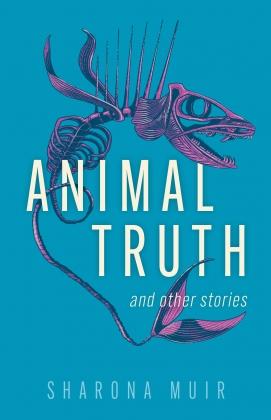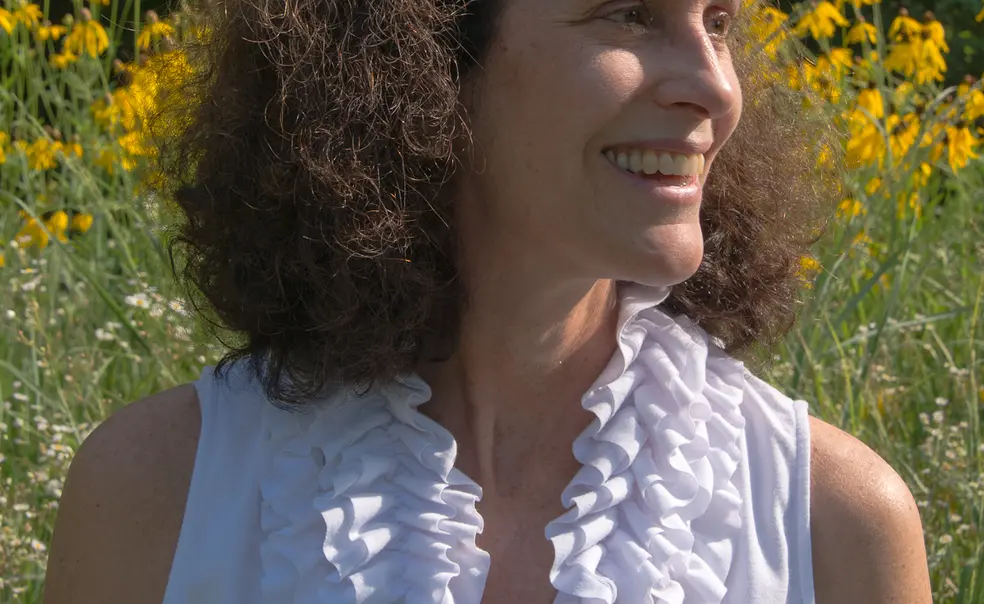Sharona Muir ’78’s New Book Launches Readers into a Mythical New World
The book: In Animal Truth and Other Stories (University of New Orleans Press) author Sharona Muir ’78 puts a new twist on classic tales like Oedipus and Faust in this collection of “eco-fabulist” stories. One such tale is about an artist obsessed with species extinction who unwittingly summons a demonic double when he creates a “banquet” featuring a baked mermaid. Muir uses these fantastical stories to inspire wonder between the world as we know it and the possibilities beyond our imaginations.

The author: Sharona Muir ’78 is a professor of creative writing and English at Bowling Green State University. After earning her undergraduate degree from Princeton in comparative literature, she completed an M.A. in English and creative writing at Boston University, and a Ph.D. in modern thought and literature at Stanford University. She is the author of four books including Invisible Beasts, which was a finalist for the Orion Prize. Muir has won various awards for her work, including the seventh annual University of New Orleans Press Lab Prize, which came with a $10,000 advance and a contract to publish. Animal Truth and Other Stories was the winner.
Excerpt:
Menu: Extinction
The young artist’s wife had begun smelling strange, lately. He was sure of it, and her odors perplexed him because she wouldn’t admit to them, but only joked and teased when he tried to probe.
“You’re sure you’re not snacking on something? Cheese? Pickles? Or could there be a change in your hormones or skin chemistry?”
Weren’t pregnant women driven to eat odd things? In Cambridge, Massachusetts, you could buy anything. He imagined strange viands, bottles with arcane labels, half-hydrated roots, reeking, tucked into the recesses of the kitchen cabinets where he thrust his stretched-out fingers that brushed only cobwebs and dead moths. He waited till she was out, then interrogated her dresser drawers as well as the steamer trunk and the bathroom’s medicine cabinet: nothing. Their tenth-floor studio in the married students’ dormitory lacked hiding places. The room was shaped like a pie wedge, the wide end being a single panoramic window overlooking a city of brick, a river, and low-flying gulls. They had two computer desks of the cheapest description, a sofa-bed partly covered by a kilim, and lots of empty beige carpet. Their dining set comprised two chrome chairs and a formica table inherited from the university and dating back to the Atomic Age; it was the butt of cozy jokes, dear to them as only an ugly trysting-place can be to a couple in love, sitting together. Their wide window — never curtained — showed a night sky dominated by a neon sign that towered up across the river dividing Cambridge from Boston. The sign cycled through its performance in a minute: Coca-Cola came gradually into view, as if the name were a hollow tube filling from the bottom with bright red light until it glowed solid; then it blinked, reappeared in encore, and dissolved into a white foam that whirled round the letters and faded into blackness … a blackness against which his eyes insisted on seeing a faint, neuro-ophthalmic Coca-Cola where the real one would, shortly, continue its cycle. The couple were as fond of the sign as a country pair might have been of a mulberry tree shading their house and splattering it with berries.
In the nighttime, the room’s walls flushed and paled; over the old chrome chairs and battered aluminum tea kettle glided a momentary candy glaze; the beige carpet reddened and sizzled with fuzzy luminosity. On their bed, the young artist’s wife was a spectacle of cherry-tipped breasts casting ruddy shadows, of brown hair glinting like flame, of thighs bloodied with transparence, of eyes reflecting a dazzled pallor. Tracing her spine, as she lay against him, he saw its groove flow red, then white. As she neared term, the gaudy pattern of the monumental sign painted her swollen body with strange poignancy, as though the essence of their time together, of this early life, were stroking their baby from outside with hands of passing light.
He adored her. But she smelled wrong.
***
“Don’t you want to check with your doctor if you’re eating anything unusual?” By daylight, she was a medium-sized brunette, rather pear-shaped even before pregnancy. Her chin dipped into her neck and out again, with a gulp of amusement that raised her lovely eyebrows. Her short-nailed scholar’s hands rested on his chest.
“Come away sweet love and play thee, lest grief and care betray thee,” she sang, clear as a wren; then lifted, with effort, her book bag and slung it over her shoulder, where it hung awkwardly off her maternity dress. “Nobody in the group says I have B.O.” She ran a madrigal group; she was getting her master’s degree in musicology and had a flair for arcana.
“It isn’t B.O.,” he protested, “you just smell like …”
“What.”
“Some incredibly weird curry. Is Jamshed feeding you his leftovers?”
“No, silly, if he did I’d share them with you. But. Maybe we shouldn’t eat at Jamshed’s all the time. Maybe there’s a clove up your nose.” She kissed his nose and left.
They had eaten weeknights at Jamshed’s since arriving in Cambridge. Jamshed, the director of a digital fabrication laboratory, was the artist’s collaborator. He believed in the alliance of the arts and sciences to defeat the global forces of ignorance and greed; he believed that if you mixed the arts and sciences together, they created the glorious combustible thing called truth. He had brought the artist here, to the lab that he ran, which was funding and producing the artist’s project, an installation called Menu: Extinction. It was to take the form of a grand banquet, celebrating — in a spirit of black irony — humanity’s power to extinguish other species. There would be a table recalling the Last Supper, and a series of sculptures representing dishes. Each dish would serve up, elaborately cooked, the last member of an endangered species — the very last of its kind. Beside each offering would lie a menu, turned to the page describing it. The banquet’s sinister cuisine would, of course, have a chef. What sort of chef, he had asked himself, would write that menu? Who would glory in serving up the last animal of an endangered species? The artist and his wife agreed that the chef would write with casual wit and nasty self-satisfaction, the style of the devil himself.
“He’s Pico,” she mused. “Who said that man is unique among the animals. But Pico gone horribly wrong — like, man is unique because he can eat all the animals.” These plans had excited him, yet the artist’s first attempts were one long stumble. For weeks, on paper and with digital aid, he conjured scores of endangered animals — spiny anteaters, silky sifakas, hirolas and addax. Hooves, horns, snouts, plumes. They fascinated him, but when he’d tried to compose the banquet scene, it flopped. Something crucial was missing. The mock-ups of Menu: Extinction kept resembling nothing so much as a prank in a natural history museum, or a severely misguided theme restaurant. The lab crew liked every one of the mock-ups: they saw the logical outcome of the project proposal. They were engineers. The artist saw the failure of his imagination.
Then a breakthrough came.
One evening in late October, the artist and his wife had entered the elevator outside their apartment door and headed down two floors, speculating as usual about how their bachelor host had gotten to live in a married dorm. They found Jamshed in an irate mood, kicking with his small Nike’d foot at some torn envelopes heaped in the middle of his beige carpet, which was even emptier than theirs. The room held only a beanbag chair that he slept in, some tenuous lamps, and a priceless, black mahogany, ChineseVictorian settee carved with writhing grotesques, which had somehow followed him from the family estate in Mumbai and was abundantly littered with papers. The Coca-Cola sign was in its ruby phase, rouging Jamshed’s round cheeks puffed with indignation. With thumb and forefinger he plucked papers from the settee and hoisted them like bits of soiled laundry. He rattled the papers, which — they learned — were marriage applications sent by his aunts in the hope that he would interview a suitable girl or two.
“This one speaks French. Should I take this one? What about these ones?” He hurled the applications in the air and blew at them, like wishing on a dandelion. They floated down through the Coca-Cola sign’s white carbonate strobe, while the artist’s wife laughed.
“You don’t have to marry them, do you?” Jamshed turned on them his black eyes, fringed with curly lashes and unusually moist, the eyelids naturally stained purple as though his ancestral line had lost sleep. “Damn right,” he grated. “I’m sorry. This really bugs me. Come sit down. I don’t need a wife anyway. Look at how I cook.”
He had prepared a delectable, conversation-quelling dinner. The couple ate with gusto, yet, seated by his wife at a different formica table spattered with butter-drops, the artist felt her constraint. He felt the indelicacy of touching her shoulder, or lifting a hair that dropped near her lips to tuck it behind her ear. And she would not pat his knee or nudge his foot. Their host’s rawness dictated it. They tried to hide what Jamshed, so likeable, was excluded from unfairly. The whole game (the artist thought) of getting someone to love was unfair. To a sensitive man like Jamshed, the game was so high stakes, and so uncontrollable, that he would naturally want to leave the table, but the table had animal legs and followed you around.
Perhaps the tension of keeping his hands from their tender habits was the triggering factor, the friction needed to strike a match in the artist’s mind at the moment when his wife, turning a lump of apricot-glazed meat around on her fork, asked, “What kind of meat is this?” “What do you think?” twinkled Jamshed. “Maybe it is owl.” There were rumors of an owl loose in the dorm; his wife wagged the unidentified lump and hooted, sounding more like a primate than a bird; and the artist said involuntarily, “That’s the problem.”
He told them, there at the crowded, messy, redolent table. An animal on a plate was meat. Intellectually, you could deplore the sight of the last dodo’s drumsticks, but at a primal level you were thinking, “Yummy drumsticks.” That was why Menu: Extinction wasn’t working. Nobody was moved at the primal level — the one that counted — by the sight of animals on plates. It was foolish.
“But … I thought … it worked,” protested Jamshed, chewing. His wife lifted her chin, adorned with a shiny fried crumb. “Suppose I ask you to imagine,” said the artist, “a mermaid. The last mermaid in the world. As an entrée in Menu: Extinction. A baked mermaid, prepared, a la Julia Child, with her tail obtruding from her open mouth, and her little fried fingers presented on a mother-of-pearl comb. How would that strike you?” His wife blinked, then said that it struck her as perfectly horrid. Which was perfect.
Excerpted from Animal Truth and Other Stories by Sharona Muir. Used by permission of the publisher, The University of New Orleans Press. All rights reserved.
Reviews:
"The balance of reality and unreality in these mind-twisting tales is sure to delight fans of Jeff VanderMeer's eco-fiction." — Publishers Weekly
"Animal Truths and Other Stories is a collection of six intimate, magical realist stories with an ecological bent, as patient and poignant as they are unsettling and fascinating." — Alice Martin, Shelf Awareness












No responses yet